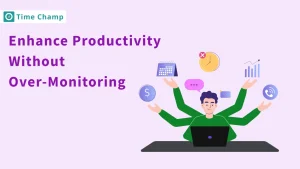Factors affecting productivity, the importance of work is an important component of which the business cannot do without. It is a fundamental aspect that connects the organizational functions and dictates how well the organization reasons. The diversity from the work environment being considered, the issues facing the employees like the physical well-being, smooth collaboration in the teams, and the management of the output will show how each task was executed.
This knowledge about these components of productivity factors allows for creating an atmosphere that is favorable for people to work in and hence can lead to the desired outcome which is success and happiness in their job.
This comprehensive guide analyzes the main components of employee involvement, key factors that turn out productivity in the business environment, and the most efficient factors affecting productivity to help run the work more effectively. Here we go then, a path towards a highly productive work structure.
What Is Employee Productivity?
Employee productivity is like the pulse of the business, as it pushes it to its goals and objectives at every stroke. It serves as a gauge of the level of employee performance and how they employ their time along with their resources to complete the tasks and goals. Factors affecting employee productivity become crucial in understanding the rhythm and efficiency of this vital business aspect.
Managers frequently measure employee productivity factors by the only means they see fit which is usually output or results such as the number of finished products, the money made, or the level of customer satisfaction. Contrary to that, they are concerned about further reasons. It reflects a team’s ability to be present, be proficient, and assess the well-being of the team.
A company with highly productive employees is like a well-tuned engine where all the parts are well-matched and working together to produce the tools for the highest level of performance. A team of operations runs the entire process by ensuring smooth and well-managed meetings as a target for every job. Besides it is not just a formality but also a powerful planning strategy to collect and meet the organization’s objective, divide the tasks, and bring together everyone. In addition to this, you can develop not only strategies that support you, but also ensure that type of progress will be yours.
What Is Productivity and Why Is It Crucial for Your Business?
In business, being productive means getting things done in a way that helps to utilize time faster, better, and with fewer resources. It is a key cost-efficiency factor companies look for when they decide upon the strategic directions and if a business neglects it, it cannot succeed either in the short term or the long term, as well as have fewer opportunities of going up. Increased productivity can lead to numerous benefits, such as
a. Increased Employee Engagement
Energy is as good as work, the more active people are the better they do work. Therefore, the possibility of having such a work environment depends on the employees’ work getting highly appreciated and being recognized for their collection of effort and commitment to the company’s goals.
b. Improved Performance Management
By providing a clear schedule of productivity goals and organized ways to monitor the progress, an organization can act timely, and effectively and be able to create change at each stage.
c. Improved Customer Satisfaction
If the performance is good, then this is like a shorter turnaround time and higher service quality, leading to increased customer satisfaction. Therefore, it not only helps customers to remain loyal but also ensures a good name for the business.
d. Enhanced Job Satisfaction
Besides the positive outcomes of this productive circumstance, employees feel satisfied in their jobs because they work and carry out duties in a confident manner leading to the fulfillment of their goals.
e. Improved Business Outcomes
Conclusively, positive performances are instrumental in growing the company’s sales, market share, and financial ratios. Factors affecting Productivity are determined by how successful a business is in a fast-changing environment where the speed changes every second. Not prioritizing your productivity is not an option it is a must.
What Are the Most Important Factors Affecting Productivity?
Factors affecting productivity include an improvement in working conditions, the proper use of technical equipment for communication, investing in people to build interaction capacity, and creating healthy surroundings. We adopt this approach because we want it to reflect on the target market and sum up all the activities as a whole through trial and error.
1. Work Environment
A well-working workplace is probably the most important workplace environment factor of all those that can influence factors affecting productivity directly by affecting the employees’ ability to accomplish tasks in a timely and comfortable manner. Let’s delve deeper into the three sub-factors mentioned:
A. Using the Right Equipment
In a world where technology plays a vital role in nearly every industry line and can affect how it functions, the assurance that you have all the necessary and efficient tools and equipment is a necessity. However, there will be a divergence of opinions on googling drawings. While someone looking for graphics will get the best results with a high-resolution monitor and powerful graphics tablet, someone searching for drawing will get better results with a low-resolution screen and a simple style.
With the same activity, the programmer funders the acceptance of a very good machine and sufficient memory for the software which does not require repairs. The tools are designed for specific industries’ wider perspectives and should be unified with employees to offer them the abilities for the best performance.Productivity enhancement of the labor components is critical in certain contexts because it is not only labor efficiency in work processes by the people that matters but also considering the situation in many different types of industries at each level.
B. Temperature and Light
Office environment, for example, brings temperature, and lighting can have significant consequences for people’s mental health like mood or level of concentration. Research has shown that people at work become more restless in the summer heat, and, as a result. As such bad lighting results in eye strain, sick headaches, and drowsiness, this leads to losses of productivity and a rise of errors too. Therefore, there is a significant need to ensure that the temperature is controlled evenly around 72 degrees F (22 degrees C) and the availability of adjustable lighting will boost the workers’ productivity, factors affecting productivity.
c. Organization of Employee Workstations
A properly arranged workstation is a symbol of an effective workplace culture. Factors affecting productivity, a messy desk can cause a loss of time as the workers search for materials and tools causing work delays. Information disorder, in addition to that, can destroy any workable order, hence contributing to more stress than is needed in the workplace. Keeping a neat workspace by using simple filing systems, well-organized storage options or electronic management of the desktop can assist in achieving a seamless workflow regardless of the tasks that one is undertaking for the day.
A neat, organized, and clean workspace not only has an aesthetic aspect but also shows respect toward the work that is being done. It will enhance responsibility in their space and workplaces. They will begin to be proud of the place themselves and the environment which is good for workplace inspiration.
Additionally, a well-structured workspace can contribute to safety through minimization of accident risks and enabling the implementation of emergency procedures unblocked. The employment environment can be designed in such a way that work not only gives excellent results but also keeps employees happy, highlighting the factors affecting productivity, if proper attention to such aspects of the workplace is paid.
2. Technology
Productivity in the workplace is significantly influenced by factors affecting technology and it is of the highest importance. Technology has already made it possible for teams to work smarter, meaning they can achieve more productivity in a shorter time with less effort. Let’s explore each technology category in more depth:
a. Project Management Tools
As one of the major supporting structures,project management, among the factors affecting productivity, on the dynamic business scene may help businesses in the platform to easily adapt to the changes. Through their management skills, the performance of the team is strengthened to work within the determined timeline, effectively collaborate, and top other issues by having it be accurate. Workflow functions can be made visible on dashboards and allocation of resources can be directed to ensure sustainable development among specific regions and set up goals and priorities.
The tools, therefore, can be described as a means for employees to be able to control the flow of work, guiding it and tracing its whole sequence of operations. The management system that is developed will be used for comfortable project information and real-time updates access will be possible to every member of the team which will prevent any communication errors and delays. Time Champ, which is our main tool, is a platform that has numerous features for much better control and management of projects.
b. Communication Tools
Today’s workplace is based on high productivity, and effective communication is one of the strong foundations for high productivity. The right communication gears can close the gaps, form a team spirit, and move the process along swiftly with the team members working on a common cause. Here’s an in-depth look at communication tools and their impact.
- Real-Time Messaging: Consider instant messaging like the express talks in the workplace. It is easy and quick – drop whatever query or update you may have and would have had to wait for an email reply before. One of the famous instant messaging apps for workplaces is Microsoft Teams.
- Video Conferencing: Through video calls, you can hold meetings with the assurance that your presentations and content will arrive correctly, so in this manner, you are experienced as if you were in the meetings physically. It’s good that they offer you the possibility of screen sharing or included recording, which is a very useful thing. Microsoft Teams and Zoom video conferencing apps are mostly used for video conferences in modern workplaces.
- Collaborative Document Editing: Now, due to the online editing of documents, any number of people can work on the same file at the same time. You don’t have to carry a bunch of slightly different versions of data around losing time in the process. Saving you a lot of time will be the main benefit.
- Project Communication Boards: They are not physical boards where task groups can stick notes indicating what currently they’re working on and update everyone on the progress. It minimizes the probability of confusion and leads to the fulfillment of the project’s objectives.
- Feedback and Survey Tools: When talking, besides a two-way communication process, we listen to our audience. To get feedback we must listen too. Surveys and input tools will lead to finding out peoples’ opinions and using these data properly.
- Unified Communications Systems: They can be considered the augmented versions of platforms that enable all these avenues of communication in one platform including calls, chats, video, and files. They are speech-to-text, image search, live translation, and many such things which help in not having to switch between a dozen applications.
c. Cloud Storage
The flexibility and the safety of the cloud storage strategy, among the factors affecting productivity, are the most useful advantages for company data management. It occurs on condition that the employees begin to cooperate with the electronic files to any appliance that has internet access. Thus, they may continue to work remotely and in places of different locations. Data safeguard covers not only whether data is available but also how complex processes of recovery and backup can undermine the loss from faulty devices, hackers, and natural disasters.
d. Brainstorming Tools
Considering the brainstorming tools, the mentioned category is a digital smart working device, which is used to be the first choice for creativity engagement, allowing one to work through ideas remotely. Software suites usually include a virtual whiteboard or sticky notes; there are also real-time comments, there are webcams, microphones and there can be streaming options. Such tools help identify the way I would address the matter if I were in charge so I can begin with Mind-map and design thinking and I can get to the root of the problem at the early stages of ideas shaping as well as brain-storming.
e. Employee Productivity Tools: –Time Champ
Time Champ takes the management of productivity to the next level and combines different features in one application to solve all problems with the convenience of keeping all functions under one app. Time Champ shines through its innovative functions as well as user-oriented approach, and simple interface, so firms have the greatest productivity capitalized on working time peak hours. Here, are some of the innovative features of Time Champ that can greatly help businesses to meet their productivity needs in modern workplaces.
i. Productivity Ratings:
For management to be successful, labor activities should be recognized and analyzed. Productivity ratings give managers a view of how they feel about the work of employees. Generally, tasks are divided into three groups:
-
Productive: Activities that positively move forward the objectives of the company.
-
Unproductive: Activities that are going against the aims of the company.
-
Neutral: The ones that neither greatly increase nor decrease productivity.
Responses provided by managers to these categories indicate how well the organization functions as a unit and how well it can meet group goals. Managers play a crucial role in identifying problems, coming up with solutions, and appointing enough time for the staff to address the problems. This feedback loop will ensure the highest level of productivity and continuous progress.
ii. Productivity Reports:
- Apps and Website Usage: Find out what apps and sites are most usually being used by employees, teams, and the entire company at large.
- Productivity Reports: Fulfill this mission by revealing the patterns and getting the required information to increase the team’s performance. By doing with weekly, monthly, or even daily reports, you can make per-user, per-team level reports customized.
- Projects & Tasks Report: Evaluation can also embody the flexibility to the form of accurately measuring the time spent on the task or projects therefore it can be projected and billed to clients. Besides the fact that it can thereof illustrate the work distribution, at the same time, it could even cut such jobs for more productivity.
- Timeline Report: Automation of the timesheet is possible through the Time Champ timer. This system works by recording work hours and tasks now, and that makes the job of producing valid invoices simple.
iii. Other advanced features
along with the Productivity tracking and management features, Time Champ is also enriched with the most advanced features like.
- Automated employee attendance tracking
- Time tracking and Time Sheet management
- Task and Project management
- Employee activity monitoring
- Location tracking and geo-fencing, etc.
Ready to see how Time Champ can revolutionize your time and productivity management? Book your free demo today and discover the full potential of your team and projects!
3. Communication
The use of well-defined communication methods, among the factors affecting productivity, helps employees understand where their efforts are being landed the various goals and targets to be met, and the progress. Establishing a culture that respects communication and sees it as the main factor of productivity can help the different teams reach the same business goal.
- Ensuring Clarity and Understanding: One of the most principal factors affecting productivity and influencing efficacy in the company, is the communication between workers in the workforce at the workplace. The conversation that can come out face to face puts the workforce in a position corresponding to the job they do and anticipation of the employer they have.
- Creating an environment of success: A platform that encourages both measurable actions and mutual shared understanding will undoubtedly affect all parts of the country’s economy. it helps to make sure that all the work of the people fits into the organization generally and everyone’s decision will be in the organization’s direction. Factors affecting productivity maintain relations essential to meeting the efficiency objective also because it avoids having the individuals spend extra time redoing their operations because of more mistakes and miscommunication.
4. Human Capital
The human capital, also recognized as one of the factors affecting productivity, which is the most valuable component of employers will be developed via proper training, motivation, engagement, and realizing that our worker’s well-being is as vital as their working ability. The health of workers and their development is what gives a happy, dedicated, and busy workforce at the end of the day and will lead to the success of the business.
a. Employee Training
The training program should form the
main part of the staff resource
training; all employees need to have
and obtain command of their task
skills and knowledge. Upgrading and
maintaining the most modern methods
and tools enables the business
process to be a competitive
advantage and in fact, better
performance in which the character
and culture of the work steps come
clearly. Job training of its staff
should be constant to ensure that
the people fulfill their tasks
within various networks and
collaborate with other
organizations. Incorporating a Learning
Management System (LMS)
can further enhance this process
by providing a centralized
platform for continuous learning
and skill
development.
b. Employee Engagement
Worker engagement is also very crucial as it supports the productivity of the workers shown by the position their heart is in and the level of preparedness they have toward their job. This sort of preference reduces the productivity of the staff. The types of their workplace environment affect how people think of themselves as powers and the key characteristics of the company have hugely determined the level of engagement. Workers can expect to stay and see that their jobs are vital to the company’s success and their hard work is essential, this is what leads to their factors affecting productivity growth.
c. Employee Satisfaction
The job satisfaction of employees within their roles also makes up the employees’ productivity, which cannot be underestimated. Satisfied employers who see their job as a favorable place to work and not just as a source of income are usually more alert, and thoroughly productive. As a result, their satisfaction may promote a more energetic and jovial office setting that lowers turnover rates hence a vibrant workplace. Employee satisfaction unlike any other factors of productivity will determine if employees are either efficient and obedient in what they do and/or if they are not.
d. Employee Health
A healthy workplace is built on productive and fit employees, which are factors affecting productivity. Maintaining physical and mental wellness creates the situation of performing a job without problems. Employers who support the health of their employees can achieve the same objective – factors of productivity in the business- by sponsoring health programs, introducing wellness benefits, or adapting a work-life balance mechanism. Back-to-the-job healthiness of an employee directly influences people’s productivity by setting the level of energy and focus one can always bring to their work responsibilities.
5. Training & Career Development Opportunities
Creating an environment of lifelong learning through training and career development programs is one of the key elements that make up the factors that affect productivity. It can be that your workforce’s growth could then end up with higher performance across the organization. Here’s how:
a. Implementing Peer-Based Learning
One of the strategies that workers with peer-based education use is to enable workers to share knowledge to support each other. By employing this technique, you are increasing the capacity of the skill pool, which is also one of the factors affecting productivity, and this maximizes chances of finding unique solutions and teamwork management. When staff speaks about personal experiences and the lessons learned, it creates a socialized culture, and that is what strengthens the team’s performance.
b. Allocating Time for Upskilling
Reskilling is about giving a chance to employee to finish their missing skills or to add new qualifications that they can use in their job. One approach that a company may take to grow the skill set of its employees is by setting time aside for upskilling. This then shows the company’s willingness to assist in the professional development of its team members. This commitment is not limited to the skills gap but also helps the workforce to be flexible to absorb the changes in the industry. Strategic upskilling hence is the present main tool of business management, to enhance factors affecting productivity and provide them a competitive edge in this fast-changing environment.
c. Encouraging Continuous Professional Development
Employers have a very significant place in the field of development of the workforce by having them close at hand for access to classes, certifications, and workshops. It used to be the environment that was the base for employee competence growth in their work areas, and regarding new technologies and up-to-date trends, as this is only one of the factors of productivity that affect individual and organizational productivity at large.
“Elevate your team’s performance with Time Champ’s innovative solutions. Sign up today
Conclusion
Here, we will analyze a few things that determine how productive a workplace is supposed to be. One of the most important priorities for business is to hire enough people who will be in a condition to make it fast and also to be trouble-free, but also to arrange an office that will be comfortable and with all the necessary office supplies, along with the implementation of technological methods which will facilitate the communication inside the company, is also one of the factors affecting productivity.
Communication will either elevate your performance level or you will not understand what is expected of you, as it will push you in the right direction. An efficient leadership role in organizational skills in communication gives the organization the ability to achieve its targets and even in the most complex atmosphere, productivity cannot be ignored.
Moreover, on the other hand, the quality of human capital is the main inspiration for high productivity or low-level productivity. Moreover, factors of productivity involving the nature of this kind of work as well as overall employee mental health whether they are enjoying their job, or having a safe and fun environment, in that working environment and career opportunities are significant in this context. One of the advantages of teamwork is that the performance of the employees increases, and the talents of different employees can be combined. Factors that determine productivity are key elements of how efficiently the workforce can be made out in a way that affects the way the worker becomes productive.
FAQ’s
Usually, it is the working environment that matters the most, which includes some factors from the workspace design to the company culture and all these factors affect the productivity of a company.
A good productivity factor results in more output but with constant resources. Machines, which automate the tasks, frequent communication at all levels, and good employees are adequate examples.
Four primary factors affect productivity: workplace environment, technology, communication, and human stuff. These two elements in unison play a critical role in the smooth running of a workplace that befits the needs of the organization.
The environment where this work is done, be it comfortable and supported by the culture, will have the effect of boosting the productivity of individuals by reducing stress which allows for better work.
Technology is an important tool for efficiency since it is used to replace manual work and assist in total organizational development by data analysis.
Yes, Communication is one of the primary pillars of productivity, as it helps to achieve clarity and direction, get timely feedback, and participate in teamwork activities.
Skilled and knowledgeable workers are highly productive, they Innovate and strive for the attainment of the goal of the company.
Employee training differs the production by arming the employees with the necessary skills to ensure that workers can complete the work tasks successfully and to that standard.
Employee engagement refers to the extent to which employees positively express their attitudes and engage mentally in their employment and work. Among the engaged staff, the job pleasure grows up and they can see how their work impacts so many things as well as their results improve.
One of Time Champ’s principal features is productivity improvement. It offers a time tracking, task management, and detailed analysis system for all teams so that they can enhance work efficiency and react more quickly to any market fluctuation.






